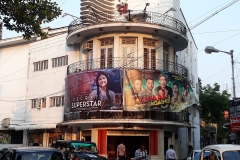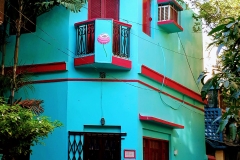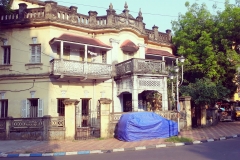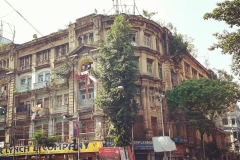A BATTLE OF THE BEHOLDERS by Rajorshi Chakraborti
There’s no less embarrassing way to put this. I first noticed Calcutta’s architectural beauty – even though I’d mostly grown up there – on a maiden trip to Paris at the age of 21.
On our opening day of marvel-filled wandering through the lanes of the Marais, where we were staying, I exclaimed to my friend ‘You know, this is so like North Calcutta.’ I was thinking specifically of regular childhood visits to see my mother’s two uncles, who lived respectively in Pathuriaghata and Baghbazar. Of course I knew the impression was imprecise – Calcutta buildings, if anything, are usually more ornate in their flourishes and details, and then there are the balconies, the wrought-iron grille work, the distinct window shutters, and above all, North Calcutta’s abundant indigenous street-life, very hard to overpower or outnumber with strolling tourists – but once the connection had been made, I began looking forward impatiently to my next visit home to be able to test and to verify it. What resemblances would emerge in their atmosphere and layout when I placed memories, or photographs, of Parisian and Calcutta’s innards side by side? What would overlap in the community life of these far-apart neighbourhoods as I now read novels set in these cities with newly alert eyes?
I find another, slightly odd recollection has cropped up in the wake of this confession – that of requiring the filter of Paris to begin to discover the beauty of hitherto-unnoticed areas (no, worse, avoided, even scorned for being frozen in time and crumbling and dirty) within my home city. These memories date from my mid-teens, before I had ever been abroad: I suddenly, but clearly, recall a period of being transfixed by skyscrapers! Again, no matter how strange it sounds, any other wording would be dishonest. Skyscrapers for me were kind of an early fetish!
What this means is that around the ages of fourteen and fifteen, if I came across a copy of National Geographic, say, and there was a feature on a Western, or Far Eastern, metropolis (New York or Toronto or Tokyo), I could spend minutes gazing at any pictures of its skyline that included its high-rises. At the time, I wasn’t even aware of any especial longing or motivation, but looking back, I suppose I must have associated tall, sleek buildings (far taller and sleeker and more plentiful than the few medium-sized towers that lined Chowringhee back then, of which incidentally Tata Centre was always my favourite; except I wished it could be higher) with things like travel, modernity, speed and adventure, or perhaps even more simply with the indescribable amorphous awesomeness of being ‘abroad’.
Now that I think about it – one embarrassing memory tugging out another like a string of sausages – much of my teenage years were spent poring over pictures of unattainable women, tall buildings and, wait for it – unfathomably complicated spaghetti junctions! Everything, in a word, that 1990s Calcutta didn’t have. J G Ballard would have sussed me out in under a minute.
And here I am already running out of space in what were meant to be just a few paragraphs accompanying some of my Calcutta house photos. So let me begin winding up by saying that my return home from that trip to Paris in 1999 was only the start of one long joy- and serendipity-filled walk over the past eighteen years through the many parts of North, Central and South Calcutta that I have come to love. I think of these especially beloved areas as the equivalent of the biodiversity hotspots on a globe – Bhowanipur, College Street, Entally, Dharmatala, Chitpur, M G Road, Sovabazar, Beck Bagan, Gariahat, Ballygunge Place, Taltala, Bara Bazar (gosh, I sound like a minibus conductor yelling out destinations) – the places where the many big and little things that I love about Calcutta’s architecture, street-life, markets, stalls, rhythms, routines, animals and people are most richly concentrated and visible. Because that is how it has unfolded for me, as a sequence of noticing that I hope will continue to deepen and become ever-more attentive: from looking closely at North Calcutta’s buildings and lanes on that first walk back from Paris to much smaller and more fleeting things over time that people all around were doing and saying; from Calcutta’s monuments to its micro-practices, from what stands or remains to what is always on the move.
Time left only to note a few last things: how I have always admired – right from my first reading of A Strange and Sublime Address – in Amit Chaudhuri’s work that he noticed, and was then able to commemorate and celebrate, so much more instinctively everything that I am still learning to see and connect.
How that first, and subsequently ever-growing awareness, of my city as deeply beautiful changed my relationship with it forever (although there was no sudden change to Calcutta; the change was only in my eyes). At least for me, there came a new confidence and a pride that a place I belonged to, and would always belong to, was also endlessly gorgeous, from so many angles, in so many ways. A friend could arrive from another great city, and in the course of a single walk I could demonstrate this. Or I could fly somewhere new, and spot resemblances and connections with Calcutta for myself. I had always known my home city to be richly interesting and multi-dimensional and alive, but only in the second half of my life (thus far) have I also delighted in its constant beauty.
It’s probably a failing of my personality to even need this kind of validation, as well as to come upon it so late (again, the failings of my personality are too vast a topic for this mini-essay). Perhaps the delay had something to do with growing up in Calcutta during the 1980s, which was a time of power cuts, dead phones and strikes, but also, more importantly, when most grown-ups around you emanated only frustration and pessimism, and if their eyes lit up when speaking of the city’s beauty, it was usually in relation to times long past.
However, I was soon to discover that falling in love with the city came with its own frustrations and helplessness as well, when you felt you could do nothing to protect so much of the beauty that you loved. So many sound interests were (are) arrayed on the side of drastic change – the profit motives of promoters, to be sure, but also the deeper, harder-to-pooh-pooh social and familial changes to the city. Five hundred families now can afford to live on a street where fifty had their homes before, and among those fifty, forty-five either have children settled outside Calcutta, or else they want the family property to be split up and shared out. People just don’t live in the same way anymore, that once allowed for those endlessly varied single-family homes. Who were passers-by like us, with no skin in the game, to posit our feeble pleas about beauty against this much socio-economy?? It was NIMBY-ism (Not In My Back Yard) of an especially odd sort, when you didn’t even own the house!
That is why I felt such a great delight when Amit and his colleagues first articulated the aims of the Calcutta Architectural Legacy project, and why I feel so thrilled and honoured for some of my pictures to be included on this site. Amit’s arguments were wonderfully inclusive on several levels – of all the beauty that he noticed in Calcutta in touches grand and small, not only in the recognised emblems of ‘heritage’; and also inclusive of everyone as a potential stakeholder not just because they were owners or residents of a building, but because they were citizens who cared. I’m thrilled about the existence of Calcutta Architectural Legacies, and grateful to Amit for this opportunity to say so, and to Sumana Roy for facilitating this connection, because it is a movement built above all on beauty. On the belief that if many more might notice the myriad beauties that are all around in our unique built environment in Calcutta, many more might wish to join the effort to preserve as much of it as possible. It is also a movement built upon realism, it seems to me: an acknowledgement that different people will see this beauty with different eyes, or perceive different possibilities in the beauty. Some will, understandably, continue to wonder what gains and losses are in it for them.
But seeing numbers might be okay too, if it prompts people to think about renewing this beauty towards altered purposes in a different time, rather than obliviously wiping out every trace of it.
For now, the goal seems to be to get more of us to notice and to inhabit Calcutta as a space of endless treasures, to delight in this and to document it, and to believe in the value of such treasures, no matter the different things each of us means by the word ‘value’.











